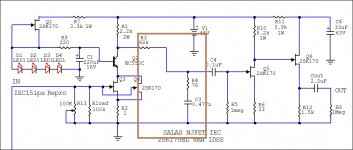Pass DIY Addict
Joined 2000
Paid Member
Depending on output level of the cartridge you are using, you may need to degenerate the jFets in the first gain stage as well. My AudioTechnica 150MLX has 5.0mV output and even after fiddling with R14/R16, it was still overloading and distorting on some LPs. Increasing R21-R24 from 10R to ~22R reduced the gain of the first stage and removed the overload I was getting. I just lifted one leg of the original resistors and added another resistor to the empty hole and connected them in series. A quick jumper will return things back to the original state.
Depending on output level of the cartridge you are using, you may need to degenerate the jFets in the first gain stage as well. My AudioTechnica 150MLX has 5.0mV output and even after fiddling with R14/R16, it was still overloading and distorting on some LPs. Increasing R21-R24 from 10R to ~22R reduced the gain of the first stage and removed the overload I was getting. I just lifted one leg of the original resistors and added another resistor to the empty hole and connected them in series. A quick jumper will return things back to the original state.
Reducing the first gain By increasing resistor values impairs noise performance. Bedides, the problem is in the second gain stage.
Pass DIY Addict
Joined 2000
Paid Member
This is interesting to know, Jack. With a 5mV output MM cartridge, I was unable to avoid overload distortion through adjustments to the second gain stage alone. Perhaps I need to experiment further. Of course, the other solution is to get a moving coil cartridge as was intended 😉
This is interesting to know, Jack. With a 5mV output MM cartridge, I was unable to avoid overload distortion through adjustments to the second gain stage alone. Perhaps I need to experiment further. Of course, the other solution is to get a moving coil cartridge as was intended 😉
If you’re clever you can skip the passive RIAA and incorporate it in the second stage feedback loop.
Pass DIY Addict
Joined 2000
Paid Member
Perhaps...?
One thing is sure, a bipolar SMPS of the proper voltage will be a challenge to find.
One thing is sure, a bipolar SMPS of the proper voltage will be a challenge to find.
One thing is sure, a bipolar SMPS of the proper voltage will be a challenge to find.
Perhaps I should stop searching for one then. LOL.
Perhaps...?
One thing is sure, a bipolar SMPS of the proper voltage will be a challenge to find.
DK shows 52 (dual) +/-24V SMPS in stock.
Unfortunately, you'll need a bit more than that if you plan to use the LMxxx regulators on Wayne's boards.
Yup. That's the issue.
I'd love to try a switcher feeding this, the newer ones really are getting quite good.
I'd love to try a switcher feeding this, the newer ones really are getting quite good.
After building successfully Pearl II phono stage it crossed my mind that I can use another kit to build a Tape head preamplifier for my reel to reel machine. I guess I will have to change loading impedance and replace RIAA correction with IEC(CCIR) equalization. Unfortunately I do not have the knowledge to calculate CCIR equalization. Can anyone help me with that. Maybe Wayne? I appreciate any help.
After building successfully Pearl II phono stage it crossed my mind that I can use another kit to build a Tape head preamplifier for my reel to reel machine. I guess I will have to change loading impedance and replace RIAA correction with IEC(CCIR) equalization. Unfortunately I do not have the knowledge to calculate CCIR equalization. Can anyone help me with that.
See this paper:
http://www.nomanlab.com/sale/lim_docs/nab_to_ccir.pdf
Very interesting read, thanks for the document. We always had tape machines at home but have not used one for at least 35 years...
And of course I wasn't aware of the corrections...
And of course I wasn't aware of the corrections...
My Pearl II project has been on hold for over a year ....life gets in the way some times. Ive been using a Dynavecter P75 III as a stop gap in the mean time. Its OK.
Once I sorted the PSU and spent some time setting the bias (bit of a fiddle) but got it to 5mv on each board.
Plugged it all in and fired up the TT dropped the needle in the groove....didnt sound right at first but after an hour or so everything settled down and it sounds very good indeed. It makes the P75 III sound a bit muddy 🙂
A pleased Pearl II builder.
Once I sorted the PSU and spent some time setting the bias (bit of a fiddle) but got it to 5mv on each board.
Plugged it all in and fired up the TT dropped the needle in the groove....didnt sound right at first but after an hour or so everything settled down and it sounds very good indeed. It makes the P75 III sound a bit muddy 🙂
A pleased Pearl II builder.
When increasing the gain of the second stage, Wayne advises we can either decrease the value of R14 or replace the short at R15 with increased resistance. If we leave R14 at 1K, what is the practical upper limit on the value we can use for R15?
Terry
Terry
Did anyone by chance save a copy of the chipamp lm3886-manual.pdf?
It used to located about 7 years ago at the link below but it appears chipamp cannot be connected to.
Thanks.
404 Not Found
It used to located about 7 years ago at the link below but it appears chipamp cannot be connected to.
Thanks.
404 Not Found
- Home
- Amplifiers
- Pass Labs
- Pearl Two
